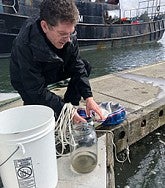Some marine worm larvae are pint-sized predators.
The small, blobby babies, less than a millimeter long, ensnare and devour microscopic crustaceans and other prey living in plankton, UO researchers report.
Their observations suggest a new lifestyle option for larval-stage invertebrates living in the ocean. Scientists usually think of plankton-dwelling larvae either growing by grazing on nanoplankton — mostly unicellular algae — or relying on the egg's yolk reserves to become full-fledged adults. Instead, it appears there’s a third strategy: carnivory.
“One of the big surprises is that these nondescript wormlets are very efficiently taking down some of the fastest prey items out there,” said UO marine biologist George von Dassow. He and his colleagues, including UO marine biologist Svetlana Maslakova and visiting graduate student Cecili Mendes, describe their findings in two new papers. Both are published in the March issue of Invertebrate Biology.
The discovery began the way so many do, via a combination of procrastination and curiosity. Von Dassow, based at the Oregon Institute of Marine Biology in Charleston, works just a short walk from the ocean. Sometimes, when he needs a break, he walks down to the marina to collect a sample of seawater and then takes it back to the lab.
If you peer into a bowl of plankton-filled seawater long enough, you’re bound to see something interesting, he said.
Von Dassow had a hunch of what to look for. Maslakova, his wife, is an expert on ribbon worm development. She had long suspected that their seemingly simple larvae were feeding on something in the plankton, but they didn’t seem interested in algae. DNA sequencing experiments in her lab suggested the larvae might be carnivorous, but they hadn’t seen it in action.
One day, in a bowl containing a variety of plankton-dwelling larvae, von Dassow spotted a larval-stage ribbon worm sucking vigorously on the armpit of a larger crustacean. As adults, these worms look like ruffly ribbons or chunky tubes, and many are top predators in sea floor food webs. But their larvae are small blobs covered in hairs called cilia.
They seem to lack many of the features biologists usually associate with a plankton-feeding lifestyle. Yet as he watched, this unassuming creature extracted and ingested every bit of meat from its victim, leaving an empty shell.

The larvae they studied mostly belonged to two major categories of marine worms, ribbon worms and flatworms. They ran observational tests, giving the worms different kinds of prey to assess their preferences and whether they could grow to adulthood on a carnivorous diet. And they sequenced DNA from the samples to match wild-caught larvae to known species of adult worms.
All told, the team observed hundreds of these events, capturing many with a video camera or a series of still photos. Their images revealed a variety of hunting strategies. Lacking more than the most rudimentary of sensory organs, the pelagic predators don’t seem to be pursuing prey through plankton.
Instead, some of the worm larvae may be acting like marine spiders, entangling prey with nets of gooey mucus. They secrete strands that act like a web, snaring prey that swim past.
Some larvae strike and stun their prey with a proboscis. Others grab onto the prey, find a crack, and then scoop out and swallow the flesh within. Ongoing studies are showcasing the repertoire of these tiny larvae.
Harvesting algae, as many marine larvae do, is a lot of work to get adequate nutrition. And larvae fed via egg yolk are a big investment for parents and are especially tasty to predators, making them vulnerable to attack. So for some marine invertebrates, this alternate strategy — snagging nutrient-dense meals via hunting — could be worth the effort.
"Rather than building specialized body parts for catching lots of tiny meals, why not just eat someone else who went to the trouble to do so?" von Dassow said.
Marine worm larvae may seem inconsequential, but these species are an important part of marine food webs, von Dassow said.
“When people think about how plankton works, and how it connects to life cycles and food webs more generally,” he said, “it's important to know how things are making a living there.” And they’re vital connections in the life cycles of the adults they’ll grow up into.
Close-to-home implications for Oregonians also are part of the story. One of the worm species studied is a parasite of the Dungeness crab, a pillar of Oregon’s fishing industry. The adult worms live on adult crabs and prey upon the crab's eggs; the parasites lay their own eggs among the crab's brood.
Hatchling larvae disperse, and then come back to crab hosts as adults. The study helps fill in a previously unknown link in the life cycle of that parasite. Knowing what the larvae are eating during the dispersal stage could help researchers better understand possible threats to the crab population.
—By Laurel Hamers, University Communications

